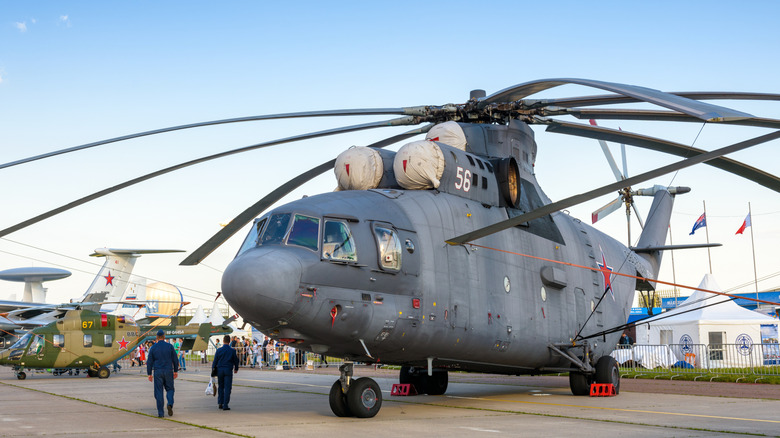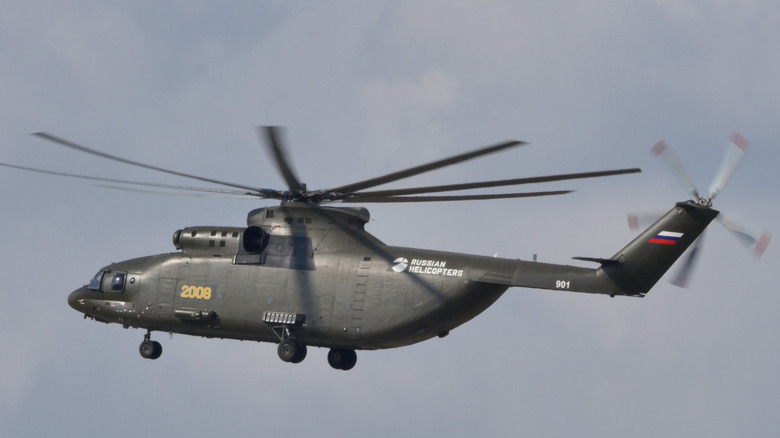The World's Strongest Heavy Lift Helicopter Can Carry A Staggering Amount Of Weight
An important aviation milestone was made in 1939 when the Sikorsky VS-300 made its maiden flight, becoming the first successful operational helicopter. It soon introduced the world to a new form of aerial transportation, a vehicle that was capable of vertical takeoff and landing. More than eighty years later, helicopters have evolved into highly sophisticated aircraft with powerful, efficient engines and avionics, capable of deployment in a diverse range of industries, including civilian and military applications. Considered versatile workhorses due to its cargo and lifting capacity and ability to go where fixed aircraft cannot, the Mil Mi-26 takes heavy transport capability to the extreme with its 44,000 lbs lift capacity.
The key to the massive lifting capacity of the Mil Mi-26 is its dual turboshaft Lotarev D-136 engines that generate 11,094 shaft horsepower each. These power the advanced 104.98-foot-long, eight-blade rotor system made from a composite of aluminum and titanium. Together, the engines and rotor give the Mil Mi-26 an impressive maximum takeoff weight capacity of 123,458 pounds, and can carry that weight for a range of nearly 500 miles.
Work on the Mil Mi-26 began in the Soviet Union during the 1970s, where it was built to replace the older Mil Mi-6 and the failed Mil V-12 concept as a military troop and equipment transport helicopter. First flown on December 14, 1977, it subsequently entered service for the Soviet military and also for commercial use in 1983. Given the NATO codename Halo, the Mil Mi-26 is huge and is one of the strangest-looking military helicopters, measuring over 110 feet long and 26.7 feet high, and to accommodate large cargo, its interior hold is 10.49 feet wide, 10.33 feet high, and nearly 50 feet long.
Biggest and most powerful helicopter
To fly and operate this enormous aircraft, the Mil Mi-26 is crewed by five personnel, and similar to the smaller legendary UH-60 Blackhawk, can be used as a troop transport, able to carry 85 passengers. When deployed for medical and evacuation missions, its interior can be reconfigured to accommodate 60 medical stretchers. Interestingly, despite its military use, the Mil Mi-26 does not have weapons and is instead outfitted with safety and threat countermeasures, including infrared jammers to avoid missile locks, self-sealing fuel tanks to minimize leaks, decoys and flares, and engine infrared signature suppressors to reduce its vulnerability against heat-seeking missiles.
As a testament to its durability, the Mil Mi-26 has been used in the Siberian sub-zero tundra, near the Swiss mountainside, and even in the deserts of Afghanistan. In terms of transported cargo, the Mil Mi-26T civilian version has shown its adaptability by carrying diverse cargo from equipment for the oil and gas industry, to earth-moving machinery for the 2008 Sichuan earthquake in China, and even the frozen remains of an Ice Age woolly mammoth. Aside from transporting large and heavy cargo, the Mil Mi-26 has also been employed to control and suppress fires, like the S-70 Firehawk firefighting helicopter.
Originally designed and built by the Moscow Mil Helicopter Plant, over 300 units of the Mil Mi-26 have been built, and its production continues today. Its most modern iteration, the Mil Mi-26T2V, being developed for the Russian military, features several improvements, including a multifunctional instrument display, improved avionics, night flying capability, and a better communications system. Despite being nearly half a century old, the Mil Mi-26's unique characteristics have kept it relevant, and it remains the biggest and most powerful heavy transport helicopter in the world.

